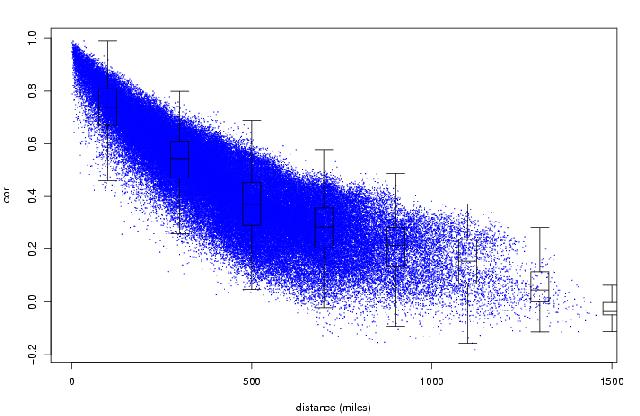Maximum 8-hr Daily Average Ground-level Ozone
Download the file,
ozmax8.dat,
which has the actual ozone measurements (max 8-hr daily average).
Units are concentrations in parts per billion (PPB).
Also, download the file,
ozmax8.info.q,
This is a list with information about the data set:
station.no, lat, lon, dates.
The times are in julian days where day 1 = JAN-01-1960. The actual times
start on April 1, 1995.
The ozone "season" runs from April through October ( 184 days) over five
years (1995 - 1999). Alternatively, if only data from the North Carolina subset is desired,
download the file
NCdat.R, which has the daily maximum 8-hr average ozone
data (ozmax8), the locations for the N.C. subset (loc) and the time points (dates). The standardized data
for this subset are also available (
NCstdO3.dat).
Load into R
From an R session, use the following commands to load them into R:
ozmax8 <- matrix( scan("ozmax8.dat"), 920,513)
source("ozmax8.info.q")
# names( ozmax8.info)
# are "stat.no" "lat" "lon" "dates" "loc"
#
# to plot station locations
plot( ozmax8.info$lat, ozmax8.info$lon)
# time series plot of first station
plot( ozmax8.info$date, ozmax8[,1])
#
#
# the next example requires the fields package from CRAN
#
library( fields)
corr <- cor( ozmax8, use = "pairwise")
up <- col( corr) > row( corr)
corr <- corr[ up]
dist <- rdist.earth( ozmax8.info$loc)[up]
plot( dist, corr, type="n", xlab="distance (miles)", ylab="cor")
points( dist, corr, pch=".", col="blue")
bplot.xy( dist, corr, add=TRUE)
rm( corr, dist, up)
# Working with the dates
# Sorry yet another R package. I find much of the date stuff
# incomprehensible!
library( chron)
# to extract calendar information
start<- c(month = 1, day = 1, year = 1960)
month.day.year( ozmax8.info$dates, origin.= start)-> look
# look has components of month, day, year
# to find the "day of year" necessary to model an annual cycle
# first reset so that day 1 of the cycle is Jan 1.
day.of.year<- (ozmax8.info$dates- julian( 12,31,1994, origin.=start))
day.of.year<- day.of.year%%365.25
The result should look like the plot below.



